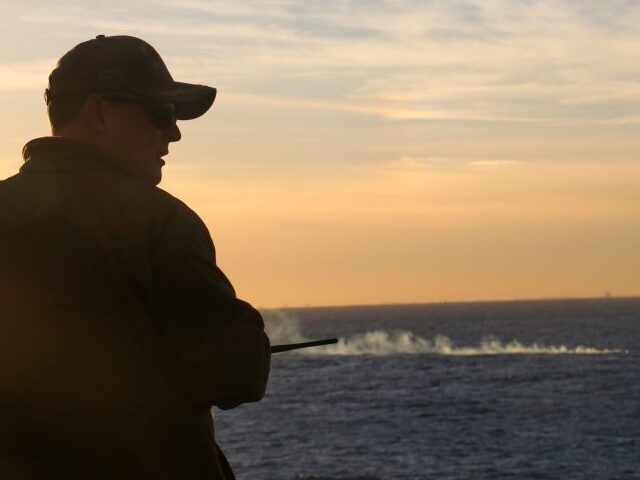The U.S. Navy is working to recover the remains of a Chinese high-altitude surveillance balloon after it was shot down over the weekend by an Air Force F-22 fighter jet.
China insists it was a weather ship blown astray and has expressed “strong dissatisfaction” over its downing, further cautioning the action may push Beijing to shoot down U.S. aircraft, as Breitbart News reported.
The Department of Defense announced Monday the recovery is taking place about six miles off the coast of South Carolina in about 50 feet of water, after rough seas reportedly prevented the safe retrieval any earlier.
The balloon was taken down as it floated over the Atlantic Ocean east of Myrtle Beach at approximately 2:40 p.m. ET on Saturday.
The USS Carter Hall has started to collect debris near the splashdown site, as the USNS Pathfinder maps the ocean floor, using sonar, the department outlined during a briefing as reported by UPI.
Watch below as the Chinese spy balloon is shot down:
Air Force Gen. Glen VanHerck, commander of the North American Aerospace Defense Command and U.S. Northern Command, said ocean currents could make it impossible to collect all of the debris and warned the public against collecting any balloon fragments that wash ashore.
“I would remind you that due to ocean currents, it’s possible that there may be some debris that does float ashore,” VanHerck said during the briefing. “And so what we would ask of the public, and you can help me with this, is avoid contact. Contact local law enforcement immediately to take care of any of that debris.”
The Navy is also working to produce a map showing the full debris field.
“We expect the debris field to be of the rough order of magnitude of about 1,500 meters by 1,500 meters, and so, you know, more than 15 football fields by 15 football fields,” VanHerck said, while adding the Navy will also determine whether the scene is safe.
They’ll be using “unmanned underwater vehicles using side scan sonar to further locate sunken debris. And so we expect them to get on there and to do some additional categorization of potential threats such as explosives that may be on, hazardous materials that could be in batteries, et cetera, so we’re working very hard,” VanHerck added.
On Monday, China’s foreign ministry spokesperson Mao Ning urged both sides, “especially the United States” to “remain calm.”
“The entry of the strayed balloon into U.S. airspace was a purely unintended, unexpected and isolated incident,” Mao said. “It tests, however, whether the United States is sincere about stabilizing and improving its relations with China and whether it can properly manage a crisis.”
The Defense Department said it is still working out where it will be sent to be examined.
“I don’t know where the debris’ going to go for a final analysis, but I will tell you that certainly the intel community, along with the law enforcement community that works this under counterintelligence, will take a good look at it,” VanHerck said. “So we look forward to moving forward there.”
The U.S. will aim to find any sensors they can in the balloon wreckage to use that to reveal the purpose of the aircraft.

Seaman Rafael Mendez stands watch aboard the USS Carter Hall while the guided-missile destroyer USS Oscar Austin and the guided-missile cruiser USS Philippine Sea transit alongside debris from a Chinese high-altitude surveillance balloon. (Lt. J.G. Jerry Ireland/U.S. Navy/UPI)
Even if the software is damaged or has been somehow wiped, investigators believe they will be able to evaluate things like the resolution and quality of surveillance images it may have taken.

COMMENTS
Please let us know if you're having issues with commenting.